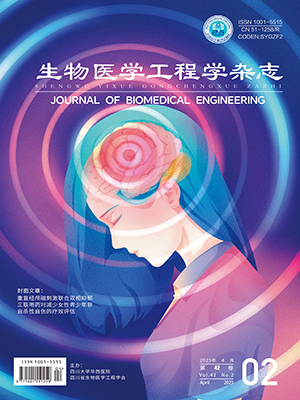Ultrasound is the best way to diagnose thyroid nodules. To discriminate benign and malignant nodules, calcification is an important characteristic. However, calcification in ultrasonic images cannot be extracted accurately because of capsule wall and other internal tissue. In this paper, deep learning was first proposed to extract calcification, and two improved methods were proposed on the basis of Alexnet convolutional neural network. First, adding the corresponding anti-pooling (unpooling) and deconvolution layers (deconv2D) made the network to be trained for the required features and finally extract the calcification feature. Second, modifying the number of convolution templates and full connection layer nodes made feature extraction more refined. The final network was the combination of two improved methods above. To verify the method presented in this article, we got 8 416 images with calcification, and 10 844 without calcification. The result showed that the accuracy of the calcification extraction was 86% by using the improved Alexnet convolutional neural network. Compared with traditional methods, it has been improved greatly, which provides effective means for the identification of benign and malignant thyroid nodules.
Citation:
ZUO Dongqi, HAN Lin, CHEN Ke, LI Cheng, HUA Zhan, LIN Jiangli. Extraction of calcification in ultrasonic images based on convolution neural network. Journal of Biomedical Engineering, 2018, 35(5): 679-687. doi: 10.7507/1001-5515.201710017
Copy
Copyright © the editorial department of Journal of Biomedical Engineering of West China Medical Publisher. All rights reserved
| 1. |
余秋. 甲状腺良恶性结节病理特征与超声弹性成像参数的相关性分析. 海南医学院学报: 1-9. DOI: 10.13210/j.cnki.jhmu.20180524.007.
|
| 2. |
高明, 郑向前. 甲状腺癌过去与未来十年. 中国肿瘤临床, 2018, 45(01): 2-6.
|
| 3. |
Seiberling K A, Dutra J C, Grant T, et al. Role of intrathyroidal calcifications detected on ultrasound as a marker of malignancy. Laryngoscope, 2004, 114(10): 1753-1757.
|
| 4. |
Hoang J K, Lee W K, Lee M, D, et al. US features of thyroid malignancy: pearls and pitfalls,. Radiographics,, 2007, 27(3): 847-860.
|
| 5. |
Chen Kuenyuan, Chen C N, Wu M H, et al. Computerized detection and quantification of microcalcifications in thyroid nodules. Ultrasound Med Biol, 2011, 37(6): 870-878.
|
| 6. |
Choi W J, Park J S, Kim K G, et al. Computerized analysis of calcification of thyroid nodules as visualized by ultrasonography. Eur J Radiol, 2015, 84(10): 1949-1953.
|
| 7. |
韩晓涛. 基于超声图像的甲状腺结节计算机辅助诊断方法研究. 成都: 西南交通大学, 2016.
|
| 8. |
Krizhevsky A, Sutskever I, Hinton G E. ImageNet classification with deep convolutional neural networks. The 25th International Conference on Neural Information Processing System, Lake Tahoe, 2012: 1097-1105.
|
| 9. |
Lawrence S, Giles C L, Tsoi A C, et al. Face recognition: a convolutional neural-network approach. IEEE Transactions on Neural Networks, 1997, 8(1): 98-113.
|
| 10. |
Howard A G. . Some improvements on deep convolutional neural network based image classification. Computer Science, 2013, arXiv: 1312. 5402.
|
| 11. |
Gu Jiuxiang, Wang Zhenhua, Jason K, et al. Recent advances in convolutional neural networks, 2017.
|
| 12. |
Szegedy C, Liu W, Jia Y, et al. Going deeper with convolutions//Proceedings of the 2015 IEEE Conference on Computer Vision and Pattern Recognition, Washington: IEEE Computer Society, 2015: 1-8.
|
- 1. 余秋. 甲状腺良恶性结节病理特征与超声弹性成像参数的相关性分析. 海南医学院学报: 1-9. DOI: 10.13210/j.cnki.jhmu.20180524.007.
- 2. 高明, 郑向前. 甲状腺癌过去与未来十年. 中国肿瘤临床, 2018, 45(01): 2-6.
- 3. Seiberling K A, Dutra J C, Grant T, et al. Role of intrathyroidal calcifications detected on ultrasound as a marker of malignancy. Laryngoscope, 2004, 114(10): 1753-1757.
- 4. Hoang J K, Lee W K, Lee M, D, et al. US features of thyroid malignancy: pearls and pitfalls,. Radiographics,, 2007, 27(3): 847-860.
- 5. Chen Kuenyuan, Chen C N, Wu M H, et al. Computerized detection and quantification of microcalcifications in thyroid nodules. Ultrasound Med Biol, 2011, 37(6): 870-878.
- 6. Choi W J, Park J S, Kim K G, et al. Computerized analysis of calcification of thyroid nodules as visualized by ultrasonography. Eur J Radiol, 2015, 84(10): 1949-1953.
- 7. 韩晓涛. 基于超声图像的甲状腺结节计算机辅助诊断方法研究. 成都: 西南交通大学, 2016.
- 8. Krizhevsky A, Sutskever I, Hinton G E. ImageNet classification with deep convolutional neural networks. The 25th International Conference on Neural Information Processing System, Lake Tahoe, 2012: 1097-1105.
- 9. Lawrence S, Giles C L, Tsoi A C, et al. Face recognition: a convolutional neural-network approach. IEEE Transactions on Neural Networks, 1997, 8(1): 98-113.
- 10. Howard A G. . Some improvements on deep convolutional neural network based image classification. Computer Science, 2013, arXiv: 1312. 5402.
- 11. Gu Jiuxiang, Wang Zhenhua, Jason K, et al. Recent advances in convolutional neural networks, 2017.
- 12. Szegedy C, Liu W, Jia Y, et al. Going deeper with convolutions//Proceedings of the 2015 IEEE Conference on Computer Vision and Pattern Recognition, Washington: IEEE Computer Society, 2015: 1-8.




